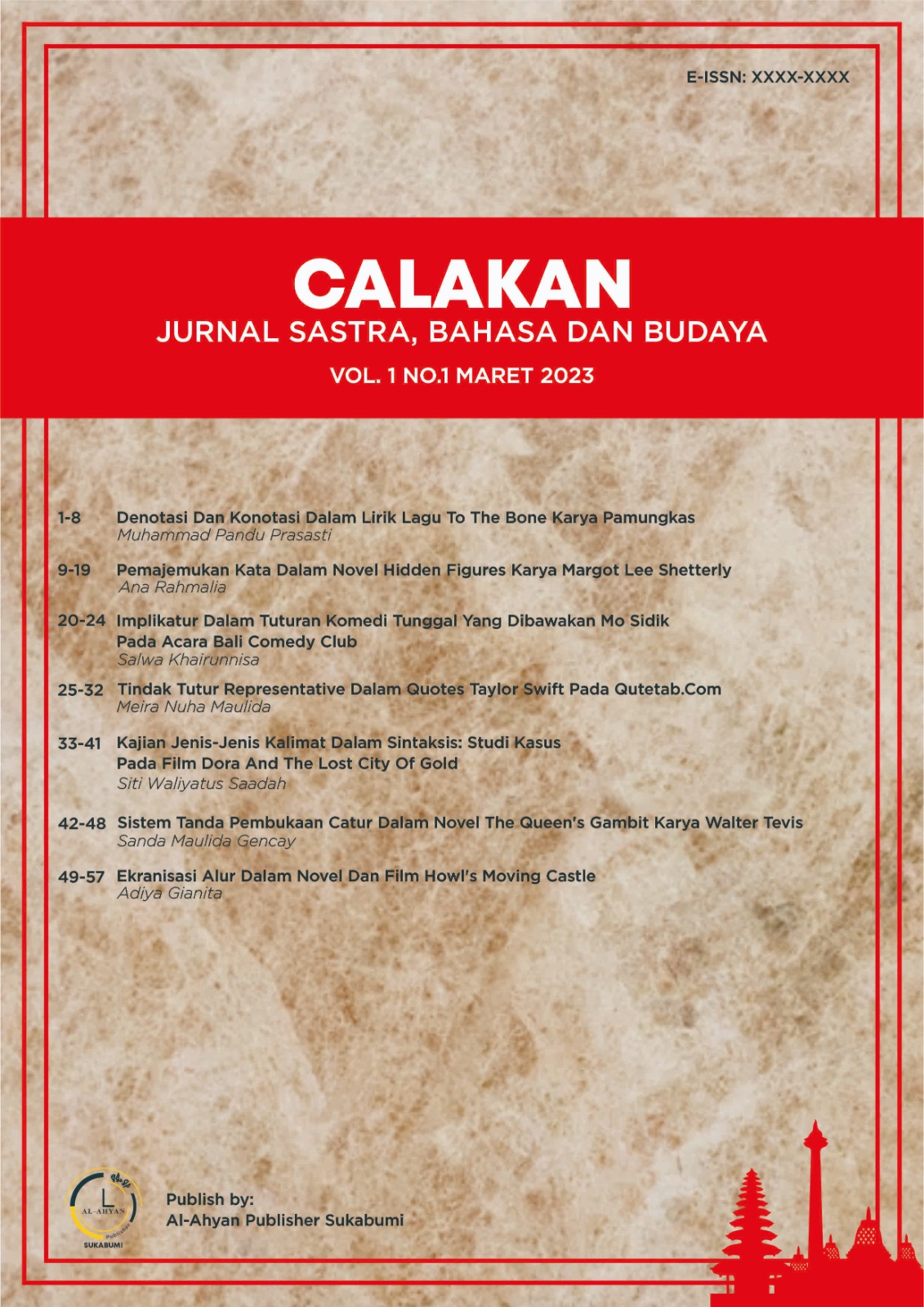Kajian Jenis-Jenis Kalimat Dalam Sintaksis: Studi Kasus Pada Film Dora And The Lost City Of Gold
DOI:
https://doi.org/10.61492/calakan.v1i1.28Keywords:
Sentence types, syntax, Movie Dora and The Lost City of GoldAbstract
This study aims to understand the types of sentences in language learning because it can help learners understand how to build and use sentences correctly and effectively. In addition, understanding sentence types can also help enrich vocabulary and sentence structures used in daily communication. In this study, the film "Dora and The Lost City of Gold" is chosen as the subject, and the researcher aims to observe and analyze how each type of sentence is used in the film. By studying the types of sentences used in the movie, the researcher hopes to contribute to the development of film theory and practice, especially in the use of effective and efficient language in building a story. This research uses a descriptive qualitative research method used to analyze qualitative data and describe it in detail. The data collection technique used is the basic listening method followed by more advanced note-taking techniques. The syntactic approach in language is used to study the structure and pattern of sentences, clauses, phrases, and words in a language. The collected data were analyzed through qualitative analysis techniques, which involved data compaction, data presentation, and conclusion drawing and verification. The results of this study reveal that there are five types of sentences used in the movie "Dora and The Lost City of Gold", namely affirmative sentences 4 data, negative sentences 14 data, interrogative sentences 6 data, imperative sentences 8 data, and exclamation sentences 2 data.
References
Chaer, A. (2015). Sintaksis Bahasa Indonesia Pendekatan proses (2nd ed.). Rineka Cipta . Fitria, D., & Sartika, R. (2021). Pemerolehan Bahasa Jenis Kalimat Dan Struktur Kalimat
Bahasa Indonesia Anak Usia 3;0-4;0 Tahun Di Paud Bimba Aiueo.
Lexy J. Moleong, Dr. M. A. (2019). Metodologi Penelitian Kualitatif (Edisi Revisi). PT. Remaja Rosda Karya. https://doi.org/10.1016/j.carbpol.2013.02.055
Miles, M. B. , A. M. H. S. jhonny. (2014). Qualitative Data Analysis (Salmon H, Ed.; 3rd ed.).
SAGE Publication. Inc.
Noortyani, R. (2017). Buku Ajar Sintaksis (Arsyad M, Ed.; Pertama). Media Pustaka. Nugrahani, F. (2014). Metode Penelitian Kualitatif dalam Penelitian Pendidikan Bahasa.
Pauzan. (2021). The book of complete english grammar ( yuche yahya. s, Ed.; pertama). PT Cipta Gadhing Artha.
Pratiwi Arsaf, N., & Juanda, J. (2022). Pemerolehan Sintaksis Anak Usia 7 Tahun 4 Bulan di Benteng Kepulauan Selayar. Jurnal Pelita PAUD, 7(1), 154–162. https://doi.org/10.33222/pelitapaud.v7i1.2501
Putrayasa, I. Bagus. (2017). Sintaksi (Memahami Kalimat Tunggal). PT Refika Aditama. Qalbi, S. U., & Nuryani, N. (2020). Jenis Kalimat pada Tuturan Anak Usia Empat Tahun:
Kajian Sintaksis. Disastra: Jurnal Pendidikan Bahasa Dan Sastra Indonesia, 2(1), 50.
https://doi.org/10.29300/disastra.v2i1.2688
Rumila, M. P. S. (2021). Sintaksis Pengantar Kemahiran Bahasa Indonesia (M. Syaukin. M, Ed.). CV. Revka Prima Media.
Supriyadi. (2014). Sintaksis Bahasa Indonesia (Munasir, Ed.; pertama). UNG Press.
Tarmini, W., Hum Dra Rr Sulstyawati, M., Hum Tim Editor Hasmawati, M., & Teknis Editing Muhammad Alfian, R. (2019). Sintaksis Bahasa Indonesia Hak Cipta © Penulis. www.uhamkapress.com
Zaim. (2014). Metode penelitian Bahasa: Pendekatan Struktural (Jumuatti, Ed.; pertama). FBS UNP Press Padang.
Downloads
Published
How to Cite
Issue
Section
License
Copyright (c) 2023 Siti Waliyatus Saadah

This work is licensed under a Creative Commons Attribution-ShareAlike 4.0 International License.










